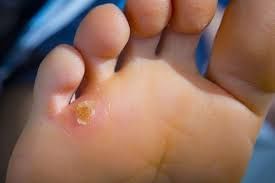Corn in Feet
A corn (or clavus, plural clavi or clavuses) is a distinctively shaped callus of dead skin that usually occurs on thin or glabrous (hairless and smooth) skin surfaces, especially on the dorsal surface of toes or fingers. They can sometimes occur on the thicker skin of the palms or bottom of the feet.
Corns form when the pressure point against the skin traces an elliptical or semi-elliptical path during the rubbing motion, the center of which is at the point of pressure, gradually widening. If there is constant stimulation of the tissue producing the corns, even after the corn is surgically removed, the skin may continue to grow as a corn.
Signs and symptoms
The hard part at the center of the corn resembles a barley seed, that is like a funnel with a broad raised top and a pointed bottom. Because of their shape, corns intensify the pressure at the tip and can cause deep tissue damage and ulceration. Hard corns are especially problematic for people with insensitive skin due to damaged nerves (e.g., in people with diabetes mellitus). The scientific name for a corn is heloma(plural helomata). A hard corn is called a heloma durum, while a soft corn is called a heloma molle.
The location of soft corns tends to differ from that of hard corns. Hard corns occur on dry, flat surfaces of skin. Soft corns (frequently found between adjacent toes) stay moist, keeping the surrounding skin soft. The corn's center is not soft, however, but indurated.
Diagnosis
To exclude other differential diagnoses, a skin biopsy may be taken.
Treatment
A popular method is to use a corn plaster, a felt ring with a core of salicylic acid that relieves pressure and erodes the hard skin. However, if an abnormal pressure source remains, the corn generally returns. If the source of any abnormal pressure is detected, this may be avoided, usually through a change to more comfortable footwear or with various types of shoe inserts or footwear with extra toe space. In extreme cases correcting gait abnormalities may be required. If no other treatment is effective, surgery may be performed.



+1.svg)
